17th Century Baroque Art Across Europe
1/12
There's no tags or description
Looks like no tags are added yet.
Name | Mastery | Learn | Test | Matching | Spaced |
|---|
No study sessions yet.
13 Terms
What does the Baroque era talk about?
It goes back to realism and an emphasis on theatrical effects.
Artists like Annibale Carracci started to play around with how light actually behaved in the real world (like how candels would work for his ceiling painting).
Three KEY things for Baroque: Drama, Movement, Lighting
Where was Baroque displayed? And to whom?
It was displayed on palaces and generally towards wealthy and elite individuals.
What did the Catholic Church do in response to Luther’s 95 thesis?
They created the Counsil of Trent which included church leaders (popes, theologins) who laid out a plan to reaffirm the teachings of the Catholic Church. They insisted that art had to be in service of the church (it had to instruct people of the catholic faith, inspire them to be faithful and moral, persuade them that catholisism was the way to go).
What is still the center of artistic innovation in the 17th century?
Rome (so all the painters here are from Rome)
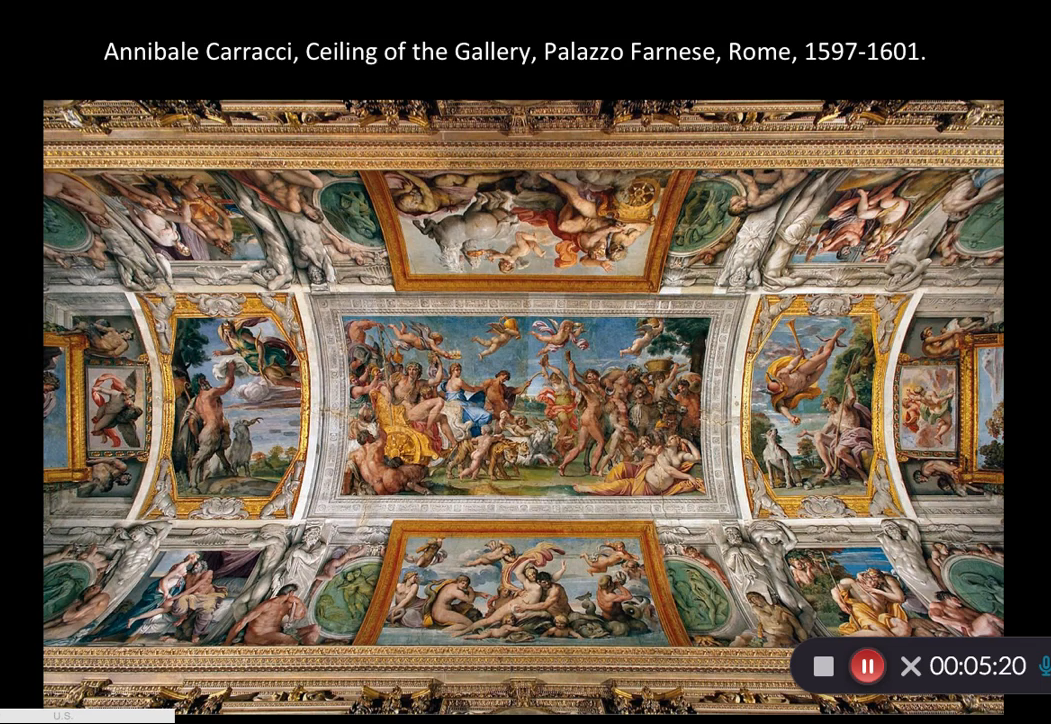
Can you describe the significance of this painting or what it means? What was so surprising about this?
The thing that was incredibly surprising about this is that the Carracci’s weren’t JUST an artistic family. They were also more workman-like (had a workshop which had students, assistants, and other people who learned this type of painting). They promoted the idea that painting could be learned with the right resources and mentors.
Big Picture: They said that you didn’t have to be GENIUS (like Michaelangelo, Leonardo, Rafael, etc)
In terms of the painting:
We see the beginnings of the Baroque style. It depicts the love of the gods, is a frescoes, and takes the subjects from Greek Mythology. All of these different frames act to pull us together. It also looks like it would be on a ceiling (there’s a ton of sky in these paintings).
Who was Caravaggio? What about his art?
He was the most famous Baroque painter. Very famous for getting into fights, provoking them.
For his art, it was very controversial: some people thought it was too realistic and didn’t give honor to the people that were depicted (this is an example).
He came from nothing—this is literally the prime example that the Caravacci was promoting!
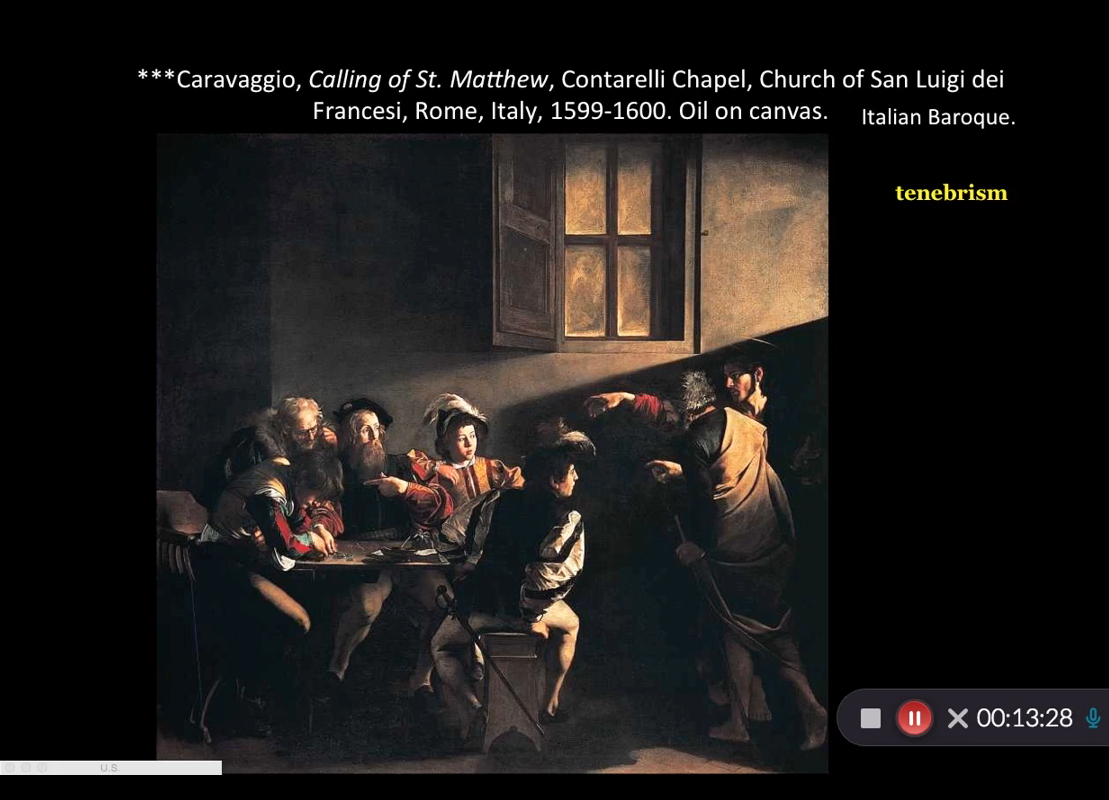
Describe this image…
This depicts a person name Matthew in Rome. Matthew was a tax collector who was not Christian yet. At the right (Saint) with Christ came to see Matthew and basically envoked him to follow them. Christ converted him to christianity as a result.
This helped people to really consider their faith in their belief.
The TRUE baroque aspect is the beaken of light that comes in which seems to carry their religious faith from that light. Caravaggio uses the light to portray the drama.
What is tenebrism?
This is used in Baroque which describe the contrast between the dark and the light and the manipulation that comes from it to CREATE DRAMA.
Who was Peter Paul Rubens?
Besides just being a painter, he was also a dealer where he purchased and sold other people’s paintings to the Dukes, dutchesses, popes, emperors. He worked himself up into a wealthy position.
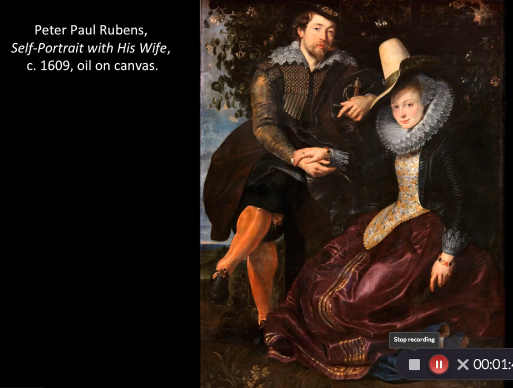
Describe this painting…
It is a self-portrait with his wife (18) and Peter was 32. This is a special portrait because it’s not something like the Renaissance in terms of a regular potrait/profile painting. There’s a ton of affection here, it’s not distant from us. The way they hold their hands is a symbol of marriage, same with the honeysuckles which are showing that faith.
Ruben specifically has the ability to take older traditions, like from the Renaissance and transform them into new ideas that paintings can achieve. We see this bright thinker/businessman who is also a creator.
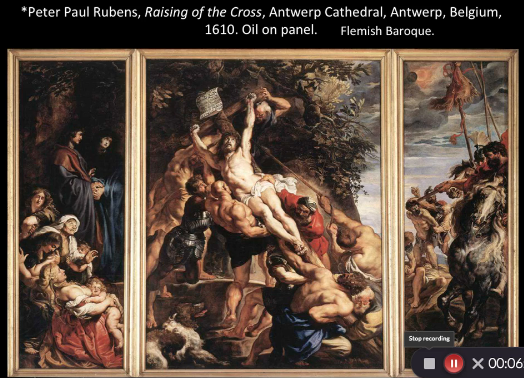
Describe this piece…
This was originally meant to be displayed in another Cathedral but it was destroyed. Rubens uses the idea of the cross and its symbolism as religious propaganda and against Protestantism.
The first revolutionary thing he does here is he COMBINES the panels, instead of having multiple scenes that are different from one another.
In the center, Christ is being crucified and people are able to see that display. On the left, we see Mary with Saint John and Mary Magdaline. On the right, we see the soldiers who are responsible for the raising of the cross. The clues we see that gives us the confirmation that this is a single scene are the clouds. They track across the portraits. There is a ton of violence and power that works against Christ, kinda like how the Protestantism is pushing Christ away from this horrible fate.
He achieves this idea of Baroque (the drama aspect specifically) through the colors and the effect of the horses trotting all around and the drama all around the scene. He uses the lighting in a brighter palate. He uses the Tenebrism to increase the overall drama, but also allows us to be drawn in by the light.
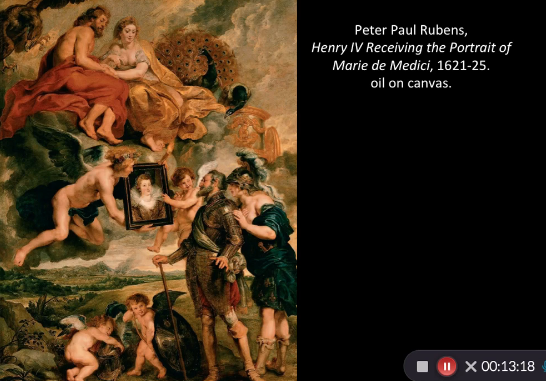
Describe this painting…
This was commissioned by Marie de Medici. She wanted him to create a cycle of 24 HUGE paintings (like this one). In this cycle, he needed to use a workshop and had other people kind of work for him. He would make small sketches that would then be transformed onto that huge canvas.
This was sent to Henry the 4th (seized) who then immediately fell in love with her. We know this because at the top of the Portrait, we see Jupiter and Juno (Zeus and Hera) who have hands together and are looking at this potential union with happiness.
He combines the real and dramatic effects through these mythological symbols.
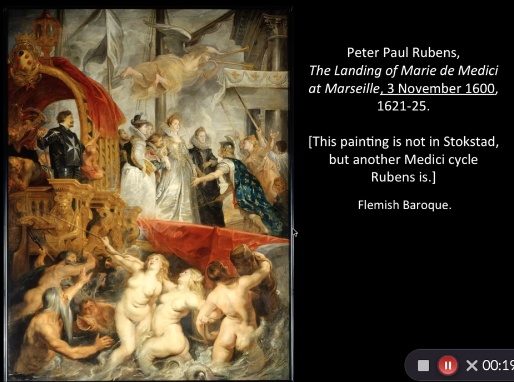
This is AFTER the one before!
This shows Marie de Medici landing at Marseille of France. She is welcomed by this personification of France (the person wearing that blue cape and helmet which are symbols of France. Oh and the Lillies, which are symbols specifically of the Kings and Queens of France).